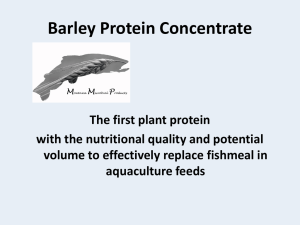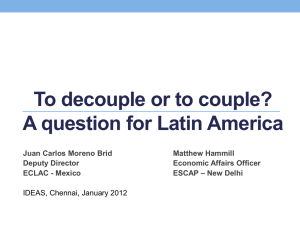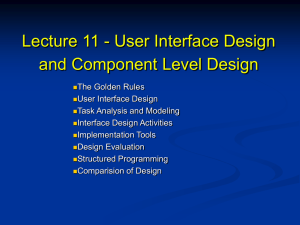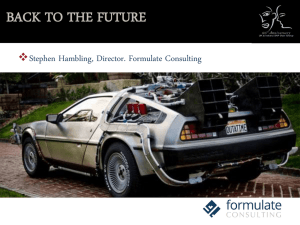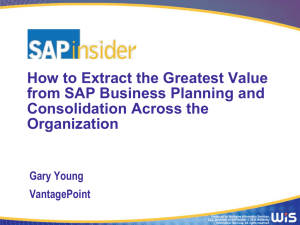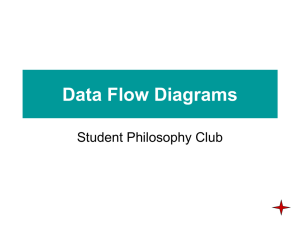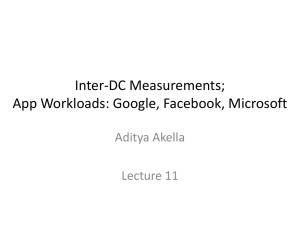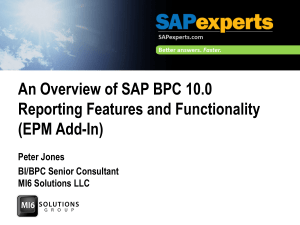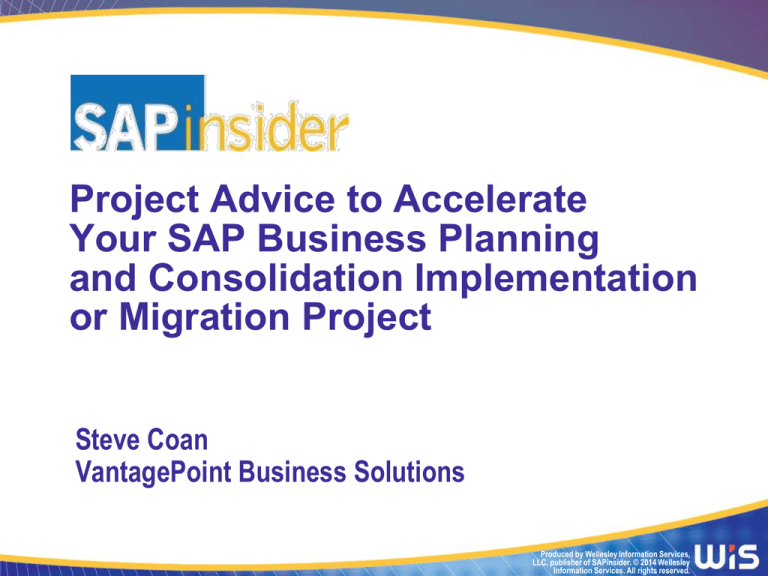
Project Advice to Accelerate
Your SAP Business Planning
and Consolidation Implementation
or Migration Project
Steve Coan
VantagePoint Business Solutions
Produced by Wellesley Information Services,
LLC, publisher of SAPinsider. © 2014 Wellesley
Information Services. All rights reserved.
Disclaimer
•
•
SAP has not endorsed or approved this presentation.
This is information based on my experience, insights, and current
information (and somewhat educated opinion) on the current and
future state of the SAP offering.
1
In This Session
•
•
•
•
•
Practical, field-tested advice on how to implement BPC
successfully and retain your sanity
Advice about data integration, validation, and ETL
The latest BPC 10.1 – Classic or Unified
BPC upgrade paths and approaches
BPC version support matrix and horizon
2
What We’ll Cover
•
•
•
•
•
•
•
Ten preparation tips for a successful BPC implementation
Five tips for identifying the right data granularity for your project
Migration options for moving to BPC 10.0/10.1 NW
Migration options for moving to BPC 10.0 MS
Migrating from EvDRE to EPM Add-In templates
SAP’s support strategy for all BPC versions
Wrap-up
3
Tip 1 — Executive Sponsorship
•
•
•
•
Is there willingness to provide sufficient resources and funding?
Does the sponsor have authority to make key decisions across
functional areas?
Is the sponsor present?
Is the sponsor engaged?
4
Tip 2 — Financial Vision
•
•
•
Is there a clear vision across all stakeholders?
Gain an understanding of desired output expected from each of
the stakeholders
Also gain an understanding of the desired input expected from
each of the stakeholders
5
Tip 3 — Communication
•
•
•
•
Do you have an effective form of communication in place
for the project?
Is there a shared directory available for project artifacts?
Personal communication is a must
Regular core team
status meetings
keep the project
on track
6
Tip 4 — Clear Requirements
•
Do you have existing, well documented processes in place?
•
Have you discussed potential new processes required and their
downstream impact?
•
Your requirements are always wrong
7
Tip 5 — Data
•
•
What is the desired level to plan/analyze, and does your actual
data support this desired level?
What other metrics are required?
8
Tip 5 — Data (Validation)
•
Don’t overestimate your knowledge of your own data
•
Don’t underestimate the time required for data validation
•
Don’t even think
of validating using
a mature, custom
report in the source
against a brand new
custom report in
BPC
•
Be patient and expect multiple iterations. Plan on it. Design for it.
9
Tip 6 — Project Team
•
•
•
•
•
Do you have the right people for the team?
Are they knowledgeable, cooperative, and results-orientated?
Make process owners and subject matter experts available during
the whole process
To mitigate risk, spread the work rather then relying only on key
people
Make sure extended
team members
understand their
roles
10
Tip 6 — Project Team (cont.)
Do you have your
and your
Business Savvy
Technologist
Technology Savvy
Business Person
?
11
Tip 7 — Critical Success Factors
•
•
•
CSFs are those few things that must go well for an endeavor to
succeed
Have stakeholders identified and agreed on CSFs?
Have you considered ongoing maintenance and support as a
CSF?
12
Tip 8 — Implementation Partner
•
Have you developed an adequate RFP to assess vendors?
•
Make arrangements to meet your finalists in person
•
Find a partner who has done similar projects
before. Many times.
•
Lean on your partner. Avoid
the trap of thinking, “We
do things differently
around here …”
13
Tip 9 — Project Management
•
Does your organization contain project management skills?
•
Will the project manager have proper authority over resources?
•
A good project manager unshackles talented team members to
make great deliveries
14
Tip 10 — Change Management
•
•
Do you expect a high level of change to your current process?
Gain an understanding of where your highest resistance will come
from, and be proactive in selling the change
Source: Spencer Johnson, M.D.
15
What We’ll Cover
•
•
•
•
•
•
•
Ten preparation tips for a successful BPC implementation
Five tips for identifying the right data granularity for your project
Migration options for moving to BPC 10.0/10.1 NW
Migration options for moving to BPC 10.0 MS
Migrating from EvDRE to EPM Add-In templates
SAP’s support strategy for all BPC versions
Wrap-up
16
Data Tip 1 — Keep the Focus on Required Insights
•
•
•
What types of questions do you want to ask of your data?
Focus on what is required for planning or reporting and not what
data is available
More is not always better
17
Data Tip 2 — Minimize Movement, Maximize Visibility
•
Focus on minimizing the data movement from one system to
another
•
Use drill-through for access to transactional data or a Webenabled transaction that is already sufficient in another system
•
HANA can handle large volumes easily, but getting all the data
into BPC involves multiple ETL steps and adds overhead, time
lag, and complexity to the environment
18
Data Tip 3 — Keep Actuals in Focus
•
•
•
You can’t report data you don’t diligently capture
Plan at the level where comparable actual data is available
Don’t confuse what “is” available with what you “would like to be”
available
Example: Planned wiper blade sales for Sedans vs. SUVs
Example: Profitability by Product instead of by Brand or Region
19
Data Tip 4 — The Right Data for Your Specific Model
•
•
Planning models have different requirements from reporting
models
A healthy BPC environment has separate models for separate
types of data:
Financials and management reporting
Capital Expenditures
Workforce/headcount management
Sales (by customer)
Expenses (by vendors)
20
Data Tip 5 — Remember the Bottom Line
•
•
Every bit of data has a cost:
Disk space
Network bandwidth
Performance degradation
Backup and recovery
Interface development
User training
Project management and documentation
Compare value provided vs. additional cost when deciding what
data to bring into BPC
21
What We’ll Cover
•
•
•
•
•
•
•
Ten preparation tips for a successful BPC implementation
Five tips for identifying the right data granularity for your project
Migration options for moving to BPC 10.0/10.1 NW
Migration options for moving to BPC 10.0 MS
Migrating from EvDRE to EPM Add-In templates
SAP’s support strategy for all BPC versions
Wrap-up
22
BPC 10.1 NW Classic vs. Unified
Feature
Classic Model
Unified Model
Data
Modeling
• Single Key Figure
• Protected Namespace
• Multi-Key Figure
• Full EDW access
Transact
Data
• All transactional records must • Transactional records can be sourced
be copied into BPC
directly from the host EDW
namespace
Master Data
• Must be copied into BPC
namespace
• Cannot use compound
master data
• Master data from the host EDW can be
utilized
• Can use compounded master data
definitions
SQL Push
Down to
HANA
• Technically possible with a
BAdI
• Capability is delivered functionality
Cell locking
• Last in wins
• First in wins
Source: SAP Platform Solution Group
23
BPC 10.1 NW Classic vs. Unified (cont.)
Feature
Classic Model
Unified Model
Calcs
• Script logic (no current plans
to execute directly on HANA)
• HANA Optimized functions:
dimension member formulas,
top down planning using
HANA, allocations using
HANA
• FOX Formula logic – many functions
capable to execute directly in HANA
• HANA Optimized functions: Copy, Repost,
Revaluation, Delete, Deletion of Invalid
Combinations, Set Key Figure Values,
Distribution by Reference Data, Generate
Combinations, repost on basis of
Characteristic Relationship, Distribution with
Keys, and Formula (many restrictions)
Consol
• Full function consolidation
• Minimal consolidation functionality – more
capability on current roadmap
Source: SAP Platform Solution Group
24
BPC 10.1 NW Classic vs. Unified (cont.)
Feature
Classic Model
Unified Model
EPM Add-In
• Direct access to BPC model
and data
• EPM Add-In supported
functions available:
• Drill thru
• Disaggregation model
selection
• Disaggregation
• Requires a BEx query acting as a data
provider to support EPM Add-In
• EPM Add-In supported functions available:
• Drill thru (on future roadmap)
• Disaggregation (on future roadmap),
workaround available today through
BEx or planning function
User
Interface
• EPM Add-In and Web
• EPM Add-In (via BEx query), Analysis for
MS Office, BEx, and Web
Source: SAP Platform Solution Group
25
Migrating to BPC 10.1 NW
BPC
10.0
NW
BW-IP
PAK
BPC
10.1
Classic
BPC
10.1
Unified
26
Migrating to Classic BPC 10.0/10.1 NW
•
Classic BPC NW Migration Paths
7.0 > 7.5 > 10.0 > 10.1
7.0 > 7.5 > 10.1
•
(Optional) BW Accelerator (BWA)
7.0 > 7.2
27
Migration Information in the PAM
Prerequisites and dependencies are in the Product Availability
Matrix (PAM)
https://support.sap.com/pam
BPC Version
Official Product Name
7.5 MS
SBOP PC 7.5 FOR MICROSOFT
10.0 MS
SBOP PC 10.0 FOR MICROSOFT
7.5 NW
SBOP PC 7.5 FOR SAP NW
10.0 NW
SBOP PC 10.0 FOR SAP NW
10.1 NW
SAP PC 10.1 FOR SAP NW
(includes Classic and Unified)
28
Migration Steps to Classic BPC 10.0/10.1
First, migrate software components
1. Migrate to BW 7.3 or 7.4 (in-place or system copy)
2. Migrate to BWA 7.2 (optional)
3. Execute the migration program
•
7.5 to 10.0 tcode: SE38, program: UJT_MIGRATE_75_TO_10
•
7.5 to 10.1 tcode: SE38, program: UJT_MIGRATE_75_TO_101
•
10.0 to 10.1 tcode: SE38, program: UJT_MIGRATE_100_TO_101
29
Migration Steps to Classic BPC 10.0/10.1 (cont.)
Next, migrate customer data and features
4. Upgrade security from Active Directory or CMS to SAP BW user accounts
•
Create SAP BW user accounts
•
Assign security roles and authorizations to the new user accounts
•
Create a tab-delimited mapping file for use by the migration program to map old users to
new users
Old User (Active Directory) New User (NetWeaver)
<Domain>\<AD User ID>
<ABAP User_ID>
5.
Deal with problems and unforeseen issues
6.
Migrate features that are not supported by the mapping program (coming slides)
7.
Regression test and validate
30
Migration Utility for BPC 7.5 NW to 10.0 NW
31
Migration Utility Parameters
32
BPC Features That Migrate from 7.5 NW to
10.0 NW
Objects, Tasks, Processes
Migrated
Administrative settings
yes
Applications > Models
yes
Dimensions
yes
Terminology adjustments for new naming conventions
yes
User IDs
yes
Owner and reviewer properties of the dimensions
yes
Security: teams, task profiles, data access profiles, assignments
yes
Journals
yes
Business rules
yes
Validation rules > controls
yes
33
BPC Features That Migrate from 7.5 NW to
10.0 NW (cont.)
Objects, Tasks, Processes
Data Manager features, including process chains, script logic,
prompts, and all other features
Content Library
Migrated
yes
yes
Business Process Flows (BPFs)
yes
Log files from the Data Manager
Live Reports (these are required to be rebuilt in the workspace
area of the new version)
Custom web pages and reports (these need to be rebuilt using the
new web reporting and input template features)
SAP BusinessObjects Dashboards (Xcelsius)
no
no
no
no
34
Viable Migration Options for Classic BPC 10.x NW
Option 1
In-Place
Option 2
Copy
Option 3
Clean Slate
Direct migration on your
current system. Migrate BW
first, then BPC
The entire system is copied
and then migrated
Perform a fresh installation of
SAP BW 7.3+ and BPC 10.x
Run UJBR to transfer data
Pros:
• Straightforward
• Technical upgrade, little or
no reimplementation
• No additional hardware or
system requirements
Pros:
• Straightforward
• Production not affected
• Technical upgrade, little or
no reimplementation
Pros:
• Most controlled and
manageable
• Clean
• Production not affected
Cons
• Disruptive
• BW and BPC systems are
completely unavailable
• Exacerbated if problems
cause delays
Cons
• Issues in current
environment may be
propagated
Cons
• Requires full installation
and configuration of all
servers, dependencies,
prerequisites, and
customizations
35
What We’ll Cover
•
•
•
•
•
•
•
Ten preparation tips for a successful BPC implementation
Five tips for identifying the right data granularity for your project
Migration options for moving to BPC 10.0/10.1 NW
Migration options for moving to BPC 10.0 MS
Migrating from EvDRE to EPM Add-In templates
SAP’s support strategy for all BPC versions
Wrap-up
36
Migrating to BPC 10.0 MICROSOFT
•
Migration on the Microsoft platform is different:
No server software migration program — BPC is uninstalled
and reinstalled with the new version
Migrating an Appset (7.5) to an Environment (10.0) is
accomplished using BPC Server Manager on the Application
Server
37
Migration Steps to BPC 10.0 MS
Migration from BPC 7.x to 10.x MICROSOFT
Server Software Migration
1. Uninstall BPC 7.x
2. Install BPC 10.0 on the Application Server
Data Migration
3. Restore the 7.x APPSET backup
4. Migrate the 7.x APPSET to a 10.0 ENVIRONMENT
5. Review the Migration Log
6. Deal with problems and unforeseen issues
7. Migrate features that are not supported by the mapping program (coming slides)
8. Regression test and validate
38
BPC Features That Migrate from 7.x MS to
10.0 MS
Objects, Tasks, Processes
Migrated
Fact table data and comments
yes
Administrative settings
yes
Applications > Models
yes
Dimensions
yes
Terminology adjustments for new naming conventions
yes
User IDs
yes
Owner and reviewer properties of the dimensions
yes
Security: teams, task profiles, data access profiles, assignments
yes
Journals
yes
Business rules
yes
39
BPC Features That Migrate from 7.x MS to
10.0 MS (cont.)
Objects, Tasks, Processes
Data Manager package lists and settings, script logic, prompts, and
all other features
Content Library
Business Process Flows (BPFs), but some have been
removed/changed
Published Books
Migrated
yes
yes
yes
yes
Log files from the Data Manager
yes
Stored procedures and other custom SQL objects
Live Reports (these are required to be rebuilt in the workspace
area of the new version)
Custom Data Manager Packages (any package with an SAP BPC
task); standard packages (Copy, Move, Admin_Optimize) can be
copied from EnvironmentShell to each Model
yes
no
no
40
BPC 10.0 MS Server Manager
41
BPC 10.0 MS Server Manager (cont.)
42
BPC 10.0 MS Server Manager (cont.)
43
BPC 10.0 MS Migration Log
44
What We’ll Cover
•
•
•
•
•
•
•
Ten preparation tips for a successful BPC implementation
Five tips for identifying the right data granularity for your project
Migration options for moving to BPC 10.0/10.1 NW
Migration options for moving to BPC 10.0 MS
Migrating from EvDRE to EPM Add-In templates
SAP’s support strategy for all BPC versions
Wrap-up
45
A Word on EvDRE > EPM Add-In Report Migration
Don’t worry
46
EvDRE Support in the EPM Add-In
•
EvDRE performs very well in the EPM Add-In
•
There is a very short list of EvDRE features and EV functions that
are not supported in BPC 10.0
•
Notable:
1. Insert Member functionality
2. EvHNV()
3. EvMNU()
4. MNU macros (e.g., MNU_eTools_Expand)
•
Refactoring and testing converted templates can be a time sink
47
Legacy EvDRE Report Migration Strategy
•
If you have in-house EvDRE expertise:
Train your organization on the new report writer
Migrate the 7.x Appset to 10.x
Identify all mission critical report and input templates
Regression test these EvDRE templates
Remediate as required
Create all new reports and input schedules using the EPM
report writer
Do all ad hoc reporting with the new EPM report writer
As proficiency increases and schedule allows, migrate the
legacy EvDRE templates
48
Legacy EvDRE Report Migration Strategy (cont.)
•
If you DO NOT have in-house EvDRE expertise:
Train your organization on the new report writer
Migrate the 7.x Appset to 10.x
Identify all mission critical report and input templates
Regression test these EvDRE templates
Decision point:
Remediate the EvDRE template, then migrate it with the
migration tool, or
Recreate from scratch using the new EPM report writer
Create new reports and input schedules using the EPM report
writer
Do all ad hoc reporting with the new EPM report writer
49
What We’ll Cover
•
•
•
•
•
•
•
Ten preparation tips for a successful BPC implementation
Five tips for identifying the right data granularity for your project
Migration options for moving to BPC 10.0/10.1 NW
Migration options for moving to BPC 10.0 MS
Migrating from EvDRE to EPM Add-In templates
SAP’s support strategy for all BPC versions
Wrap-up
50
SAP’s Support Strategy for All BPC Versions
Version
GA*
EOMM**
Location
Migration < From
Calculations
FOX, HANA Optimized
functions
Jun, 2014
12/31/2020
EDW
BW Integrated Planning
(BW-IP), Planning
Application Kit (PAK)
Jun, 2014
12/31/2020
/CPMB/
BPC 10.0
BPC Advanced Logic, BAdI
10.0 NW
Apr, 2012
12/31/2020
/CPMB/
BPC 7.5 NW < BPC 7.0 NW
BPC Advanced Logic, BAdI
7.5 NW
Aug, 2010
12/31/2017
/CPMB/
BPC 7.0 NW
BPC Advanced Logic, BAdI
7.0 NW
Apr, 2009
3/31/2016
N/A
10.0 M
Feb, 2012
12/31/2020
7.5 M
Dec, 2009
3/31/2016
7.0 M
Aug, 2008
3/31/2016
/CPMB/
Any SQL
instance
Any SQL
instance
Any SQL
instance
BPC Advanced Logic, BAdI
BPC Advanced Logic,
Stored Procedures
BPC Advanced Logic,
Stored Procedures
BPC Advanced Logic,
Stored Procedures
10.1 NW
Unified
10.1 NW
Classic
BPC 7.0 M, BPC 7.5 M
BPC 7.0 M
N/A
*Generally
**End
Available
of Mainstream Maintenance
51
What We’ll Cover
•
•
•
•
•
•
•
Ten preparation tips for a successful BPC implementation
Five tips for identifying the right data granularity for your project
Migration options for moving to BPC 10.0/10.1 NW
Migration options for moving to BPC 10.0 MS
Migrating from EvDRE to EPM Add-In templates
SAP’s support strategy for all BPC versions
Wrap-up
52
Return on Investment
It goes to 11,
doesn’t it?
53
How to contact me:
Steve Coan
scoan@vantagepoint-solutions.com
Please remember to complete your session evaluation
54
Disclaimer
SAP and other SAP products and services mentioned herein as well as their respective logos are trademarks or registered trademarks of SAP SE (or
an SAP affiliate company) in Germany and other countries. All other product and service names mentioned are the trademarks of their respective
companies. Wellesley Information Services is neither owned nor controlled by SAP SE.
55

